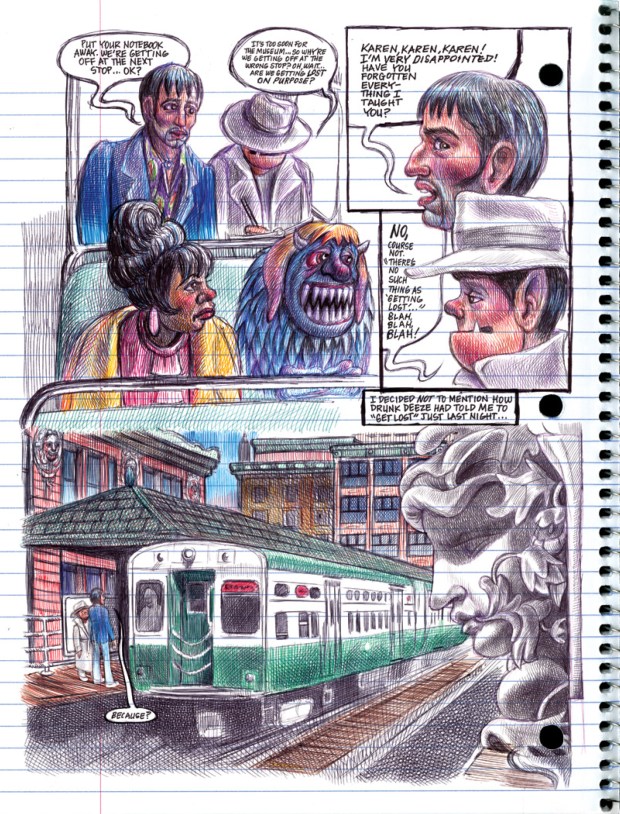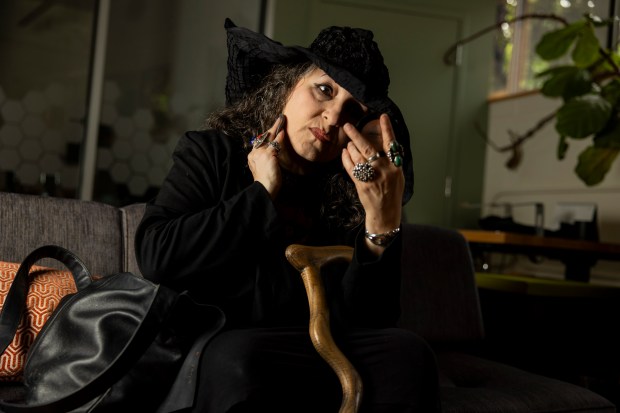Emil Ferris won the lottery seven years ago. She knows this. She didn’t win the Illinois Lotto. She won the artist’s lottery, which costs far more than $2 to play, and no matter if you are a pianist or playwright, it’s the crueler, more arbitrary game. Even in a field of long shots, she was unlikely. She was already in her 50s, scraping by as an Evanston illustrator and sometime product designer (for McDonald’s Happy Meals, among other things). Worse, Ferris had made a graphic novel so dense and sprawling, its manuscript pushed north of 600 pages long. Its initial publisher decided that it was just too… much.
But Fantagraphics, the venerable Seattle comics publisher of everything from “Peanuts” to Chris Ware, grabbed it. They would release it as companion books, the second coming six months after the first. The book, “My Favorite Thing is Monsters,” with its sweaty caricatures and latticed, ballpoint collages, tucked inside a package made to resemble the school notebook of an alienated girl in Uptown who wants to be a werewolf and befriends a Holocaust survivor, was such a baroque, accomplished swing for the creative fences, it resembled a life’s work. I remember a Fantagraphics staffer telling me that the publisher had wondered if this out-of-nowhere Chicagoan even existed. Or was this “Emil Ferris” the pseudonym for a known genius?
No, no — Emil Ferris lives, breathes, writes, draws.
Seven years after “My Favorite Thing is Monsters” became a rare publishing phenom — a blockbuster graphic novel, with more than 100,000 copies sold — “My Favorite Thing is Monsters: Book Two” has finally arrived. When we met in Evanston the other day, I hadn’t seen her in six years. In fact, the last time we spoke, theater and film director Sam Mendes (“American Beauty”) had been circling the book to develop the inevitable movie adaptation. “Didn’t end up happening,” she smiled. Mendes came and went. And so did others. She’s still looking for the proper fit, she said. “Heart of Gold” strummed languidly over the restaurant speakers. “I am looking for my heart of gold,” Ferris said.
This in itself is telling.
Ferris carries weight now, juice. Things have changed since she won the artist’s lottery. For one, she’s in her 60s now, though still has a dark earth-mother quality, with a graying cascade of hair and ethereal, philosophical airiness. She also spun “My Favorite Thing is Monsters” into a deal with a bigger publisher, Pantheon, for new works, two graphic novels taking place (like “My Favorite Thing”) in the tawdrier Northside of the ‘60s. She’s also working on additional comics, a short story collection, an autobiographical book and a “deviant” turn-of-the-19th-century science fiction novel set in a polygamist community.
“There are a lot of things possible,” she said.
Success does wonders for confidence.
“I think the only gift that any writer or artist of any kind wants to be given is the (audience’s) willingness to travel with the storyteller, and I found out people would be willing to travel with me and Karen (Reyes, the anxious schoolgirl/werewolf heroine of the books). And I was absolutely flummoxed, gobsmacked, bedazzled and bedeviled.”
She’s also a touch cagier now.
The first time I spoke to her we rode the CTA and chatted, and this time, we sat across a table and after I took out a recorder, Ferris took out a recorder. “You know what,” she explained, “the reason I do that these days, I had the most terrifying conversation with my attorney, who said ‘By the way, if someone gets ahold of your recording because they hacked you, you could be saying anything they wanted…’ You have to be careful.”
She’s talking about a fear of AI manipulation, though she’s quick to note — partly with a wink, partly serious, partly because her favorite thing really is monsters — she doesn’t want to anger her coming AI overlords. “I’m not challenging AI, believe me. This is a real creature who has its own personalities and opinions. This is the new Frankenstein, and I am not about to insult the new Frankenstein. I only hope the new Frankenstein allows itself to be loved deeply and becomes what it wants to be. Because every Frankenstein wants to become Dr. Frankenstein. Every Pinocchio wants to be a real boy. You know?”
The last thing Emil Ferris needs is a digital Frankenstein.
She’s moving to a new place in Chicago because her Evanston home flooded. Though in the scheme of things, it’s really nothing. Any telling of her story, which has been well documented, is retelling a series of unfortunate events, spanning decades: Because of severe scoliosis, she spent part of her childhood — from about 4th to 8th grade, at Gale elementary school in Rogers Park — in a body cast that stretched from her neck to her hips. She was sexually assaulted as a child. She recalls refusing to stand for the Pledge of Allegiance at Gale (in a grade-school protest of Vietnam) and being lifted up by her ears by the school principal, tearing her earlobe. She related to monsters. She left home at 16. At her 40th birthday party, she was bitten by a mosquito and contracted West Nile virus, which left her speechless, with meningitis, encephalitis and some brain damage. She was also paralyzed from the waist down, and for a time, lost control of her drawing hand. She began to attend the School of the Art Institute of Chicago, albeit in a wheelchair.
By working with a striking crosshatched drawing style during this time (one so intricate that it would eventually include reproductions of AIC masterworks), “My Favorite Thing is Monsters” took six years to finish. Then, just before publication, the full 10,000-copy run from Fantagraphics was trapped in the Panama Canal after the shipping company’s owners went bankrupt and the Panamanian government seized the ship’s contents.
If only that was everything.
The second “My Favorite Thing is Monsters” became an ugly legal football, between artist and publisher. According to documents filed in 2021 by Fantagraphics in a Washington state district court, even before the first book was published, Ferris asked to hone the second. Deadlines were pushed, publishing dates were pushed. According to Fantagraphics — which said this was the first time in the company’s five decades it sued one of its authors — Ferris “blamed her failure to deliver the promised version on her mental and/or physical health, on a defective computer, and on her claimed need to generate other income,” eventually claiming Fantagraphics also didn’t have a right to the second book. According to Ferris’s counterclaim, the publisher was “bullying its breakout star author,” and “consistently underreported and underpaid her royalties.” They came to a settlement in 2022, but after book two was delivered in 2023, the case was dismissed.
So why did book two take so long?
It reads like a seamless, touching continuation of the first, going deeper into Karen’s noirish Uptown, her sexuality and political awakening, partly tied to the 1968 police riots in Grant Park.
Ferris won’t discuss the lawsuit or why she left Fantagraphics for Pantheon.
Instead, she told me: “The thing takes the time it takes. That’s the thing I learned. You don’t get to decide everything. You have to listen to your characters. This is kind of personal, but at some point, Karen said to me — about the way I had finished the book — ‘I wouldn’t do that. I know you want me to. But I wouldn’t do it.’ I said, ‘OK, what would you do?’ And Karen said, ‘Just start telling my story. Just draw and I’ll tell you what happens.’ I was like, ‘OK muse! This is screwing me up…’ But stories don’t come to you the way a widget comes out of the factory. They come in this really messed up way.”
She said the the 50 extra pages she initially had for the second book were “unusable because it was wrong. It wasn’t what happens. It wasn’t what the characters would do.”
I said that’s probably hard for a publisher to hear.
She said, “That’s too bad.”
Time moves faster now, faster than it did before she was a success.
Assuming nothing else bad happens.
She will leave that to the universe, she said. If the universe says more bad stuff needs to happen so that she can learn from it, she won’t fight. “But — it would be great if it was only a neck-down thing. Or only a mid-thorax-down paralysis. That’d be cool if it fulfilled my learning. And if it doesn’t? I’m going to trust what I have to learn. You arrive at the place you need to be having gone through what was required of you to arrive there.”
cborrelli@chicagotribune.com




